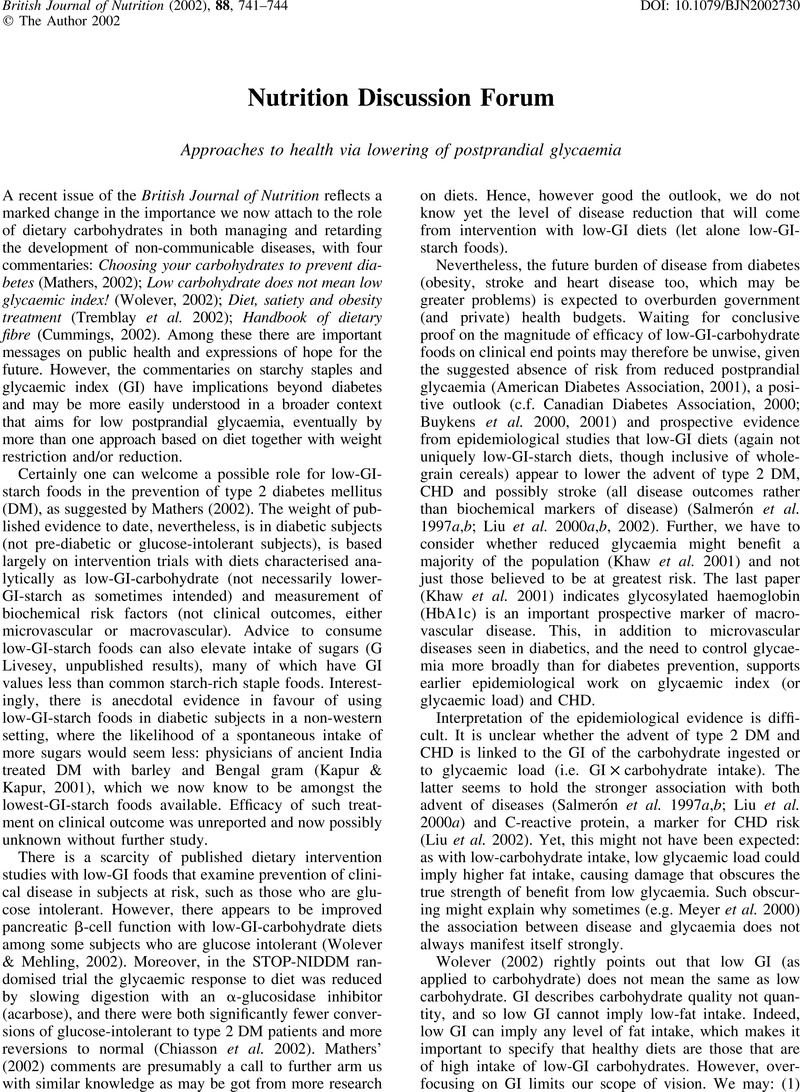Crossref Citations
This article has been cited by the following publications. This list is generated based on data provided by Crossref.
Lupton, Joanne R.
and
Turner, Nancy D.
2003.
Dietary fiber and coronary disease: Does the evidence support an association?.
Current Atherosclerosis Reports,
Vol. 5,
Issue. 6,
p.
500.
Tercedor Sánchez, Jesús
and
López de la Torre Casares, Martín
2003.
Acné y dieta.
Piel,
Vol. 18,
Issue. 9,
p.
468.
Livesey, Geoffrey
2003.
Health potential of polyols as sugar replacers, with emphasis on low glycaemic properties.
Nutrition Research Reviews,
Vol. 16,
Issue. 2,
p.
163.
Vermorel, M.
Coudray, C.
Wils, D.
Sinaud, S.
Tressol, J. C.
Montaurier, C.
Vernet, J.
Brandolini, M.
Bouteloup-Demange, C.
and
Rayssiguier, Y.
2004.
Energy value of a low-digestible carbohydrate, NUTRIOSE� FB, and its impact on magnesium, calcium and zinc apparent absorption and retention in healthy young men.
European Journal of Nutrition,
Vol. 43,
Issue. 6,
p.
344.
Livesey, Geoffrey
2005.
Low-glycaemic diets and health: implications for obesity.
Proceedings of the Nutrition Society,
Vol. 64,
Issue. 1,
p.
105.
Brouns, F.
Bjorck, I.
Frayn, K. N.
Gibbs, A. L.
Lang, V.
Slama, G.
and
Wolever, T. M. S.
2005.
Glycaemic index methodology.
Nutrition Research Reviews,
Vol. 18,
Issue. 1,
p.
145.
Livesey, Geoffrey
2006.
Sweeteners and Sugar Alternatives in Food Technology.
p.
1.
Bornet, Francis R.J.
Jardy-Gennetier, Anne-Elodie
Jacquet, Noémie
and
Stowell, Julian
2007.
Glycaemic response to foods: Impact on satiety and long-term weight regulation.
Appetite,
Vol. 49,
Issue. 3,
p.
535.
NIWANO, Yoshimi
ADACHI, Takashi
KASHIMURA, Jun
SAKATA, Takashi
SASAKI, Hajime
SEKINE, Kazunori
YAMAMOTO, Satoshi
YONEKUBO, Akie
and
KIMURA, Shuichi
2009.
Is Glycemic Index of Food a Feasible Predictor of Appetite, Hunger, and Satiety?.
Journal of Nutritional Science and Vitaminology,
Vol. 55,
Issue. 3,
p.
201.
Razzaq, Hussam AA
Sutton, Kevin H
and
Motoi, Lidia
2011.
Modifying glucose release from high carbohydrate foods with natural polymers extracted from cereals.
Journal of the Science of Food and Agriculture,
Vol. 91,
Issue. 14,
p.
2621.
Livesey, Geoffrey
2012.
Sweeteners and Sugar Alternatives in Food Technology.
p.
1.
Razzaq, Hussam AA
Sutton, Kevin H
and
Motoi, Lidia
2013.
Altering the rate of glucose release from starch‐based foods by spray‐drying with an extract from barley.
Journal of the Science of Food and Agriculture,
Vol. 93,
Issue. 11,
p.
2654.



